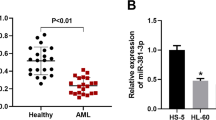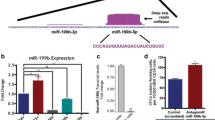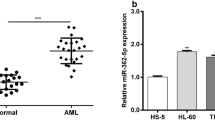Abstract
Arsenic trioxide (ATO) treatment effectively prolongs the overall survival of patients with acute promyelocytic leukemia (APL). Mutations in the oncogene PML::RARA were found in patients with ATO-resistant and relapsed APL. However, some relapsed patients do not have such mutations. Here, we performed microarray analysis of samples from newly diagnosed and relapsed APL, and found different microRNA (miRNA) expression patterns between these two groups. Among the differentially expressed miRNAs, miR-603 was expressed at the lowest level in relapsed patients. The expression of miR-603 and its predicted target tropomyosin-related kinase B (TrkB) were determined by PCR and Western blot. Proliferation was measured using an MTT assay, while apoptosis, cell cycle and CD11b expression were analyzed using flow cytometry. In APL patients, the expression of miR-603 was negatively correlated with that of TrkB. miR-603 directly targeted TrkB and downregulated TrkB expression in the APL cell line NB4. miR-603 increased cell proliferation by promoting the differentiation and inhibiting the apoptosis of NB4 cells. This study shows that the miR-603/ TrkB axis may be a potent therapeutic target for relapsed APL.




Similar content being viewed by others

Data Availability
The data are available from the corresponding author on reasonable request.
References
Mistry AR, Pedersen EW, Solomon E, Grimwade D (2003) The molecular pathogenesis of acute promyelocytic leukaemia: implications for the clinical management of the disease. Blood Rev 17(2):71–97
Wang ZY, Chen Z (2008) Acute promyelocytic leukemia: from highly fatal to highly curable. Blood 111(5):2505–2515
Coombs CC, Tavakkoli M, Tallman MS (2015) Acute promyelocytic leukemia: where did we start, where are we now, and the future. Blood Cancer J 5(4):e304
Carbone R, Botrugno OA, Ronzoni S, Insinga A, Di Croce L, Pelicci PG, Minucci S (2006) Recruitment of the histone methyltransferase SUV39H1 and its role in the oncogenic properties of the leukemia-associated PML-retinoic acid receptor fusion protein. Mol Cell Biol 26(4):1288–1296
Hoemme C, Peerzada A, Behre G, Wang Y, McClelland M, Nieselt K, Zschunke M, Disselhoff C, Agrawal S, Isken F et al (2008) Chromatin modifications induced by PML-RARalpha repress critical targets in leukemogenesis as analyzed by ChIP-Chip. Blood 111(5):2887–2895
Bartel DP (2009) MicroRNAs: target recognition and regulatory functions. Cell 136(2):215–233
Chen CZ, Li L, Lodish HF, Bartel DP (2004) MicroRNAs modulate hematopoietic lineage differentiation. Science 303(5654):83–86
Havelange V, Garzon R, Croce CM (2009) MicroRNAs: new players in acute myeloid leukaemia. Br J Cancer 101(5):743–748
Fazi F, Rosa A, Fatica A, Gelmetti V, De Marchis ML, Nervi C, Bozzoni I (2005) A minicircuitry comprised of microRNA-223 and transcription factors NFI-A and C/EBPalpha regulates human granulopoiesis. Cell 123(5):819–831
Pulikkan JA, Dengler V, Peramangalam PS, Peer Zada AA, Müller-Tidow C, Bohlander SK, Tenen DG, Behre G (2010) Cell-cycle regulator E2F1 and microRNA-223 comprise an autoregulatory negative feedback loop in acute myeloid leukemia. Blood 115(9):1768–1778
Pulikkan JA, Peramangalam PS, Dengler V, Ho PA, Preudhomme C, Meshinchi S, Christopeit M, Nibourel O, Müller-Tidow C, Bohlander SK et al (2010) C/EBPα regulated microRNA-34a targets E2F3 during granulopoiesis and is down-regulated in AML with CEBPA mutations. Blood 116(25):5638–5649
Katzerke C, Madan V, Gerloff D, Bräuer-Hartmann D, Hartmann JU, Wurm AA, Müller-Tidow C, Schnittger S, Tenen DG, Niederwieser D et al (2013) Transcription factor C/EBPα-induced microRNA-30c inactivates Notch1 during granulopoiesis and is downregulated in acute myeloid leukemia. Blood 122(14):2433–2442
Garzon R, Pichiorri F, Palumbo T, Visentini M, Aqeilan R, Cimmino A, Wang H, Sun H, Volinia S, Alder H et al (2007) MicroRNA gene expression during retinoic acid-induced differentiation of human acute promyelocytic leukemia. Oncogene 26(28):4148–4157
Serafim Junior V, Fernandes GMM, Oliveira-Cucolo JG, Pavarino EC, Goloni-Bertollo EM (2020) Role of Tropomyosin-related kinase B receptor and brain-derived neurotrophic factor in cancer. Cytokine 136:155270
Malekan M, Nezamabadi SS, Samami E, Mohebalizadeh M, Saghazadeh A, Rezaei N (2023) BDNF and its signaling in cancer. J Cancer Res Clin Oncol 149(6):2621–2636
Maroder M, Bellavia D, Meco D, Napolitano M, Stigliano A, Alesse E, Vacca A, Giannini G, Frati L, Gulino A et al (1996) Expression of trKB neurotrophin receptor during T cell development. Role of brain derived neurotrophic factor in immature thymocyte survival. J Immunol 157(7):2864–2872
Abbaci A, Talbot H, Saada S, Gachard N, Abraham J, Jaccard A, Bordessoule D, Fauchais AL, Naves T, Jauberteau MO (2018) Neurotensin receptor type 2 protects B-cell chronic lymphocytic leukemia cells from apoptosis. Oncogene 37(6):756–767
Li Z, Beutel G, Rhein M, Meyer J, Koenecke C, Neumann T, Yang M, Krauter J, von Neuhoff N, Heuser M et al (2009) High-affinity neurotrophin receptors and ligands promote leukemogenesis. Blood 113(9):2028–2037
Guo M, Zhang X, Wang G, Sun J, Jiang Z, Khadarian K, Yu S, Zhao Y, Xie C, Zhang K et al (2015) miR-603 promotes glioma cell growth via Wnt/β-catenin pathway by inhibiting WIF1 and CTNNBIP1. Cancer Lett 360(1):76–86
Sell SL, Widen SG, Prough DS, Hellmich HL (2020) Principal component analysis of blood microRNA datasets facilitates diagnosis of diverse diseases. PLoS ONE 15(6):e0234185
Cocco E, Scaltriti M, Drilon A (2018) NTRK fusion-positive cancers and TRK inhibitor therapy. Nat Rev Clin Oncol 15(12):731–747
Yuzugullu H, Von T, Thorpe LM, Walker SR, Roberts TM, Frank DA, Zhao JJ (2016) NTRK2 activation cooperates with PTEN deficiency in T-ALL through activation of both the PI3K-AKT and JAK-STAT3 pathways. Cell Discov 2:16030
Liu J, Zhu HH, Jiang H, Jiang Q, Huang XJ (2016) Varying responses of PML-RARA with different genetic mutations to arsenic trioxide. Blood 127(2):243–250
Lehmann-Che J, Bally C, de Thé H (2014) Resistance to therapy in acute promyelocytic leukemia. N Engl J Med 371(12):1170–1172
Zhu HH, Qin YZ, Huang XJ (2014) Resistance to arsenic therapy in acute promyelocytic leukemia. N Engl J Med 370(19):1864–1866
Madan V, Shyamsunder P, Han L, Mayakonda A, Nagata Y, Sundaresan J, Kanojia D, Yoshida K, Ganesan S, Hattori N et al (2016) Comprehensive mutational analysis of primary and relapse acute promyelocytic leukemia. Leukemia 30(12):2430
Careccia S, Mainardi S, Pelosi A, Gurtner A, Diverio D, Riccioni R, Testa U, Pelosi E, Piaggio G, Sacchi A et al (2009) A restricted signature of miRNAs distinguishes APL blasts from normal promyelocytes. Oncogene 28(45):4034–4040
Zamani A, Fattahi Dolatabadi N, Houshmand M, Nabavizadeh N (2021) miR-324-3p and miR-508-5p expression levels could serve as potential diagnostic and multidrug-resistant biomarkers in childhood acute lymphoblastic leukemia. Leuk Res 109:106643
Cao Y, Liu Y, Shang L, Chen H, Yue Y, Dong W, Guo Y, Yang H, Yang X, Gu W et al (2022) Overexpression of miR-17 predicts adverse prognosis and disease recurrence for acute myeloid leukemia. Int J Clin Oncol 27(7):1222–1232
Zhang TJ, Lin J, Zhou JD, Li XX, Zhang W, Guo H, Xu ZJ, Yan Y, Ma JC, Qian J (2018) High bone marrow miR-19b level predicts poor prognosis and disease recurrence in de novo acute myeloid leukemia. Gene 640:79–85
Wang F, Li J, Li L, Chen Z, Wang N, Zhu M, Mi H, Xiong Y, Guo G, Gu Y (2022) Circular RNA circ_IRAK3 contributes to tumor growth through upregulating KIF2A via adsorbing miR-603 in breast cancer. Cancer Cell Int 22(1):81
Ma C, Zhan C, Yuan H, Cui Y, Zhang Z (2016) MicroRNA-603 functions as an oncogene by suppressing BRCC2 protein translation in osteosarcoma. Oncol Rep 35(6):3257–3264
Lin YX, Wu XB, Zheng CW, Zhang QL, Zhang GQ, Chen K, Zhan Q, An FM (2021) Mechanistic Investigation on the Regulation of FABP1 by the IL-6/miR-603 Signaling in the Pathogenesis of Hepatocellular Carcinoma. Biomed Res Int 2021:8579658
Yin B, Ma ZY, Zhou ZW, Gao WC, Du ZG, Zhao ZH, Li QQ (2015) The TrkB+ cancer stem cells contribute to post-chemotherapy recurrence of triple-negative breast cancers in an orthotopic mouse model. Oncogene 34(6):761–770
Bao L, Wang YT, Lu MQ, Shi L, Chu B, Gao S (2023) BDNF/TrkB confers bortezomib resistance in multiple myeloma by inducing BRINP3. Biochim Biophys Acta Gen Subj 1867(3):130299
Chendamarai E, Ganesan S, Alex AA, Kamath V, Nair SC, Nellickal AJ, Janet NB, Srivastava V, Lakshmi KM, Viswabandya A et al (2015) Comparison of newly diagnosed and relapsed patients with acute promyelocytic leukemia treated with arsenic trioxide: insight into mechanisms of resistance. PLoS ONE 10(3):e0121912
Yang T, Li J, Zhuo Z, Zeng H, Tan T, Miao L, Zheng M, Yang J, Pan J, Hu C et al (2022) TTF1 suppresses neuroblastoma growth and induces neuroblastoma differentiation by targeting TrkA and the miR-204/TrkB axis. iScience 25(7):104655
Takahashi S (2021) Current Understandings of Myeloid Differentiation Inducers in Leukemia Therapy. Acta Haematol 144(4):380–388
Takahashi S (2022) Kinase Inhibitors and Interferons as Other Myeloid Differentiation Inducers in Leukemia Therapy. Acta Haematol 145(2):113–121
Villiers W, Kelly A, He XH, Kaufman-Cook J, Elbasir A, Bensmail H, Lavender P, Dillon R, Mifsud B, Osborne C (2023) Multi-omics and machine learning reveal context-specific gene regulatory activities of PML::RARA in acute promyelocytic leukemia. Nat Commun 14(1):724
Funding
This research was supported by the National Natural Science Foundation of China (81903966) and the Science Foundation of the First Affiliated Hospital of Harbin Medical University (2021M02).
Author information
Authors and Affiliations
Contributions
Huibo Li conceived, carried out experiments and wrote the paper; Jinxiao Hou analyzed data; Yueyue Fu and Yanqiu Zhao carried out experiments and analyzed the data; Jie Liu and Dan Guo performed the experiments; Ruiqi Lei, Yiting Wu and Linqing Tang performed the experiments. Shengjin Fan conceived the experiments and revised the paper. All authors gave final approval of the submitted and published versions.
Corresponding author
Ethics declarations
Ethics approval
All experimental procedures were approved by the First Affiliated Hospital, Harbin Medical University.
Competing interests
The authors declare no competing interests.
Conflict of interest
None of the authors have any financial interest related to this work and therefore declare no conflict of interest.
Additional information
Publisher's Note
Springer Nature remains neutral with regard to jurisdictional claims in published maps and institutional affiliations.
Rights and permissions
Springer Nature or its licensor (e.g. a society or other partner) holds exclusive rights to this article under a publishing agreement with the author(s) or other rightsholder(s); author self-archiving of the accepted manuscript version of this article is solely governed by the terms of such publishing agreement and applicable law.
About this article
Cite this article
Li, H., Hou, J., Fu, Y. et al. miR-603 promotes cell proliferation and differentiation by targeting TrkB in acute promyelocytic leukemia. Ann Hematol 102, 3357–3367 (2023). https://doi.org/10.1007/s00277-023-05441-w
Received:
Accepted:
Published:
Issue Date:
DOI: https://doi.org/10.1007/s00277-023-05441-w



